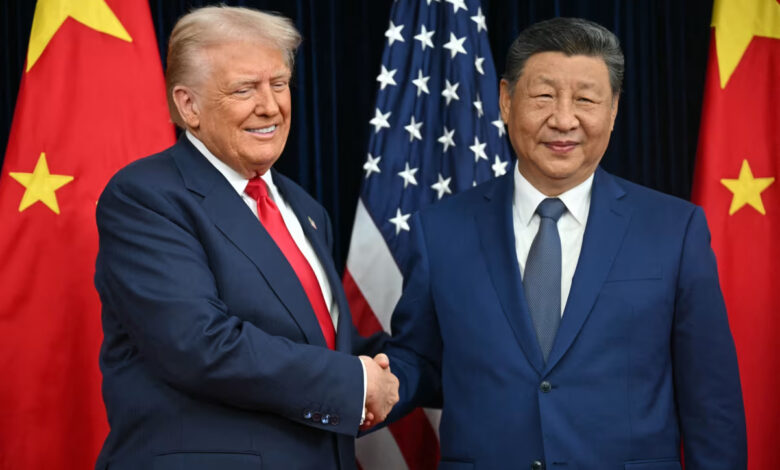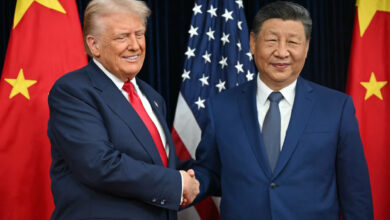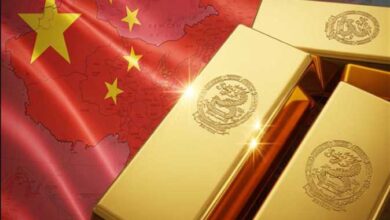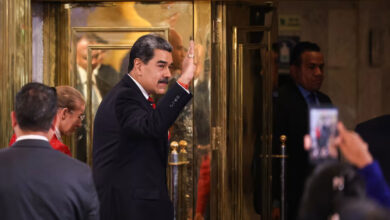
A landmark meeting between Chinese leader Xi Jinping and US President Donald Trump on the sidelines of an international summit in South Korea Thursday appears to have made major strides to resolve frictions in the volatile relationship between the world’s two largest economies and rival superpowers.
The two leaders had agreed on “almost everything” and reached a trade deal that could be signed “pretty soon,” Trump told reporters on Air Force One after wrapping up the highly anticipated meeting with Xi, which capped his five-day tour of Asia.
Xi also pointed to the “consensus” reached on resolving “important economic and trade issues” and called on the two sides to “refine and finalize follow-up work as soon as possible, uphold and implement the consensus, and deliver tangible results,” according to a Chinese readout.
“Economic and trade relations should continue to be the ballast and engine of Sino-US relations, not a stumbling block or point of conflict,” the Chinese leader said.
The two appeared to find common ground on their duelling export controls, with a readout from Beijing saying that the Chinese sides would suspend for one year the implementation of sweeping export controls on rare earth minerals, in exchange for the US hitting a one-year pause on a rule announced in September that would vastly expand the number of Chinese companies restricted from buying certain American technologies.
In his comments to reporters, Trump said the understanding would “eliminate” roadblocks to the export of the strategically critical materials and could be renewed each year. He did not explicitly mention the pause on the US rules.
Under their consensus, the US would reduce by 10 percent of existing tariffs on Chinese imports – in exchange for what Trump said was Xi’s pledge to crack down further on China’s role in the flow of the deadly drug fentanyl into the US. A truce that reduced an escalation from both sides to triple-digit levies earlier this year would remain in effect, according to statement from both sides.
Trump said that would bring the overall tariff rate on Chinese goods to 47 percent. China said it would make “corresponding adjustments” to its US tariffs.
China would also ramp up purchases of “tremendous amounts” of American soybeans, Trump said, with Beijing noting that the two sides had “reached consensus” on expanding agricultural trade. Beijing also said the two sides would suspend tit-for-tat port fees targeting each other’s shipping sectors.
One of China’s top concerns – US export controls blocking its access to high end technology including semi-conductors – was discussed, according to Trump, but didn’t appear to have yielded any new breakthroughs.
The one-hour-and forty-minute meeting – the leaders’ first in six years – also appeared provide a key venue for the two men to stress their interest in stabilizing their countries’ fractious relationship.

In comments ahead of the talks, Trump praised Xi as the “great leader of a great country” and said he thought the two “were going to have a fantastic relationship for a long period of time,” while the Chinese leader said it was a “great pleasure” to see Trump after many years.
“We do not always see eye to eye with each other, and it is normal for the two leading economies of the world to have frictions now and then … you and I at the helm of China-US relations should stay the right course,” Xi said, adding the two nations could “prosper together.
Troubled trade
The global economy has for months been roiled by a tit-for-tat of mounting tariffs, export controls and other penalties hitting areas from high-tech goods to high-seas shipping, as the US and China have vacillated between escalation and negotiation.
At the crux of those tensions are a gaping trade imbalance and efforts from the US to ensure its national security against an increasingly assertive China, including by expanding restrictions on China’s access to American high tech, like the advanced semiconductors needed to power AI.
Trump also appeared to raise the stakes of the meeting moments before landing in Busan, announcing the end of a more than three-decade moratorium on US nuclear testing.
Trump said the US “has more Nuclear Weapons than any other country,” naming Russia as second and China “a distant third,” but catching up.
“Because of other countries testing programs, I have instructed the Department of War to start testing our Nuclear Weapons on an equal basis. That process will begin immediately,” he wrote. It was not immediately clear what he was referring to as neither of the three countries has tested nuclear weapons since the 1990s.
The statement added to other twists and turns ahead of the meeting, including Trump openly questioning whether it would happen and threatening additional tariffs and export controls on critical software in recent weeks.
Eleventh-hour trade negotiations by top officials in Kuala Lumpur, Malaysia, set the meeting on track. Expectations rose on both sides, sources familiar with the matter told CNN, with the hopes that the deal would produce more than just a low-key touchpoint between the two world leaders.
But the consensus reached will be just one touchstone in a thorny and volatile great power rivalry between the world’s superpower democracy and an authoritarian China, whose growing military assertiveness under Xi in the East and South China Seas is rattling US allies in the region.
Both sides have seen a leader-level meeting as key to stabilizing the relationship as they continue to grapple with how to structure their economic ties.
The meeting offered a win for China, which wants predictability in its US relations while it sprints toward self-sufficiency from American high-tech, and also for Trump, whose meeting with Xi delivers a big-ticket finale for what has already been a dealmaking blitz across Asia.
CNN’s John Liu contributed to this report.




